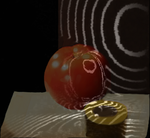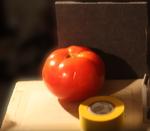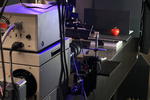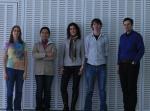Pictures
Videos
A laser pulse moving through a bottle
 Pulse moving through a bottle. Color encodes time. Background image added. |
 Pulse moving through a bottle. Background image added. |
 Photo of the bottle taken by a regular camera |
bottle.mov
bottle.mp4 The movie with background image.
bottlefast.mov
bottlefast.mp4 The movie with background image at a higher frame rate.
bottle_long.mp4 Composition of movies and pictures of the scene. This
video includes the black and white raw data. Also available on youtube.
A fruit illuminated by a pulsed light source
 Pulsed illumination of a fruit. Background image added. |
 Pulsed illumination of a fruit. Color encodes time. Raw data. |
 Pulsed illumination of a fruit. Background image added. |
 Photo of the fruit taken by a regular camera. |
 Photo of the fruit computed from data taken by the fast camera. |
fruit.mov
fruit.mp4 The movie with background image.
fruit_fast.mov
fruit_fast.mp4 The movie with background image at a higher frame rate.
fruit_long.mp4 Composition of movies and pictures of the scene. This
video includes the black and white raw data. Also available on youtube.
A roll of tape and a fruit Illuminated by a pulsed light source
 Pulsed illumination of the scene. Color encodes time. Background image added. |
 Pulsed illumination of the scene. Background image added. |
 Photo of the scene taken by a regular camera. |
fruittape.mov
fruittape.mp4 The movie with background image.
fruittape_animation.avi A computer animation to illustrate the laser path.
fruittape_fast.mov
fruittape_fast.mp4 The movie with background image at a higher frame
rate.
fruittape_long.mp4 Composition of movies and pictures of the scene. This
video includes the black and white raw data. Also available on
youtube
fruittape_long2.mp4 Composition of movies and pictures of the scene. This
video includes the black and white raw data and the illustration video. Also
available on youtube
A collection of scenes including:
a piece of rock candy,
an orange (hit from the back),
the corner of 3 walls,
a small cup and some grapes,
a grating under water.
multiple_scenes.mp4 This video is also available on youtube.
Other Pictures and Videos
 Photo of the camera and a scene |
 Photo of the camera and a scene |
streak_animation.avi







